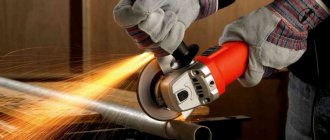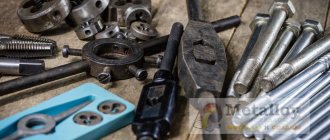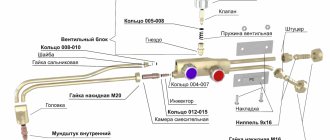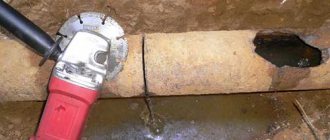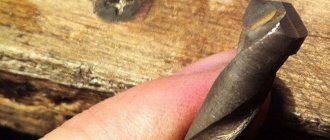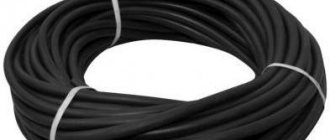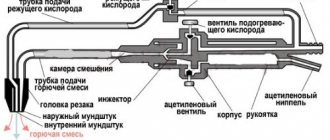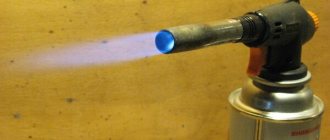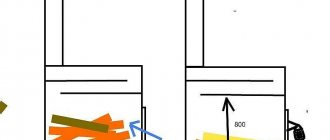Device and parameters
An apparatus for cutting metal parts using gas consists of several elements. The master needs to know its structure in order to take certain measures in case of breakdown or jamming. Main details:
- handle;
- frame;
- channels for supplying flammable gas and oxygen;
- mouthpiece;
- a nozzle responsible for the formation of a burning jet.
In addition to the key elements, the metal cutter has gas supply regulators, a system of channels through which they pass through the body and reach the outlet openings. The dimensions of the apparatus for cutting metal parts are smaller than that of a grinder, however, the burner requires the connection of cylinders with consumables, which complicates the delivery of the equipment to the workplace.
Design and features of a gas burner
The cutting torch consists of the following elements:
- tube for supplying gas and oxygen;
- head with two replaceable special mouthpieces;
- 3 valves (for flammable gas, regulation and direct supply of the necessary oxygen);
- lever;
- mixing chamber in which the necessary mixture of cutting and fuel gases is formed.
The listed elements are the main components of this tool, since its design may include a larger number of other parts.
Gas cutter for metal: varieties
Gas cutters for metal are divided according to different criteria. For example, there is a classification based on the gas used, dimensions, type of cutting, design, and method of mixing consumables.
Acetylenic
It is a metal cutter that is used for cutting thick metal parts. Acetylene equipment is equipped with additional valves that allow you to set a high gas supply rate. There are industrial and portable models of cutters. Acetylene provides maximum flame temperature. This results in a greater depth of metal cutting.
Acetylene metal cutter
Propane
Propane-powered equipment is used for cutting alloys, non-ferrous and ferrous metals. The maximum cutting thickness is 300 mm. Propane cutters are more reliable, which ensures their durability during active use. Masters pay attention to the safety of such devices. They are often used when carrying out independent work in private workshops.
Portable cutting torch
You can buy a device for autonomous operation. Mini cutters fit in the palm of your hand. They are a metal canister of gas onto which a nozzle with a flammable substance supply system is screwed. You can compare a hand-held device with a turbo lighter. Using matches, a lighter or an installed ignition system, the gas is ignited and passes through special nozzles and nozzles, which form a thin stream of high-temperature flame. It does not go out in strong winds, which makes it easy to use a handheld cutter outdoors. To fill a small can, you can use a special refill nipple or buy a new full container.
Tips from experts on working with a cutter
Experienced carvers advise always using high-quality personal protective equipment:
- special glasses;
- gloves (mittens), jacket and pants with fire-resistant properties;
- special work shoes.
The workplace must also be properly equipped. The location of gas cylinders is at a distance of 5 m from hot work. The workshop should be well ventilated, the floor should be concrete or earthen. The flame of the gas-oxygen burner should be located frontally relative to the gas supply hoses. Hoses must not interfere with work.
It is also important to have auxiliary tools and devices for marking work - pencil (chalk), tape measure, square, ruler. To ignite the flame, you will need a special lighter, which the carver should always have at hand.
At the end of the work, you need to carefully inspect the workplace so as not to accidentally step on a piece of molten metal, which can burn through even the thick sole of your shoes. The cut metal blanks are usually left to cool in natural conditions, but if necessary, forced cooling with water is allowed - this must be done carefully so that hot splashes do not get on the skin.
Advantages and disadvantages
If you need to cut a metal sheet, you can use different equipment and devices. This could be a roller knife, hand scissors, a grinder, a laser or water cutting machine. Each method has strengths and weaknesses. Advantages of gas cutters:
- Large cutting thickness. Depending on the type of equipment chosen, it is possible to cut a metal sheet with a thickness of 500 mm.
- Low price for burner, cylinders, connecting hoses.
Flaws:
- When a metal is heated strongly, it undergoes thermal deformation. Because of this, the structure of the material changes.
- Large cutting width, which is unacceptable if the exact dimensions are observed.
- If the sheet thickness is small, a flame cone is noticeable on the cut.
- Inability to work with stainless steel and non-ferrous metals.
- High cost per meter of cut sheet.
After cutting metal sheets using a gas torch, you need to additionally process the ends.
To make a quality cut, you need to control the distance between the torch nozzle and the surface of the material. To do this, you need to make a homemade carriage that will support the working part of the equipment in one position above the metal sheet.
Cutting torch
Selection rules
When choosing a cutting torch, you need to consider a number of recommendations. You should pay attention to the following factors:
- Comfort is an important indicator that determines how long a technician can work with the device without fatigue. It is advisable to hold the burner in your hands. This will help you understand how comfortable it will be while working.
- Mouthpiece material - the outer part of this burner element should be made of chromium bronze. Pure copper with a red tint is acceptable.
- Connecting tubes must be made of brass.
- It is advisable to choose a burner without a decorative coating. The paint will cover possible defects in the assembly of the device.
- When working with oily or painted surfaces, you need to choose long cutters (up to 800 mm). This length will protect the brush from injury from the flame.
- Choose an aluminum handle. Plastic is less durable and wear-resistant.
- Flame temperature and gas flow rate affect the cutting thickness of metal parts. The cutting depth is indicated by special markings. For example, if you need to cut sheets up to 10 cm thick, the machine will be designated P. To cut sheets thicker than 10 cm, you need to select the P3 marking.
It is important to check the equipment before leaving the store. To avoid unnecessary problems in case of possible breakdowns of the gas burner, it is necessary to obtain a guarantee.
Features of choice
To avoid mistakes, before purchasing a gas cutter, it is important to familiarize yourself with some of the design features of the device. This will allow you to understand what primary factors you need to pay attention to when choosing it.
Selection rules:
- Nipples - made of brass and aluminum, the former are considered more durable.
- Mouthpieces - the outer one is usually made of chrome bronze or pure copper (distinguished by a reddish tint). For acetylene devices, it is also desirable for the internal one to be copper; for others, the use of brass analogues is allowed.
- Connecting tubes are made of brass. At the same time, they should not have a decorative coating that can hide minor defects.
- Valve spindles are made of stainless steel; brass spindles have a short service life.
- Handle – aluminum is considered the best material, plastic is less wear-resistant. Its size must be at least 40 mm to have a comfortable girth.
- Cutter length – for cutting thick metal, as well as painted or oily materials, it is better to choose devices up to 1000 mm in size. In other cases, you can buy 500 mm burners.
Photo 5. Basic consumables for gas cutters
Also, when purchasing, it is recommended to take the tool in your hands and check it for ease of use. The productivity and time the master can work with a cutter without fatigue directly depends on this.
Setting up a cutting torch
After purchasing the equipment, you need to assemble and configure it. Stages of device assembly:
- It is necessary to install a reducer on two cylinders. Red is set to propane, blue to oxygen. Before screwing it on, you need to check the presence of rubber seals. The valves themselves must be free of oil or grease.
- Next you need to secure the gas supply hoses. They are screwed into the threads of the gearboxes. Secure with clamps. It is better to use metal fasteners.
- After connecting the hoses to the cylinders, you need to secure them to the burner according to the diagram specified in the instructions. It is included with the device.
When the assembly is completed, you can proceed to the configuration stage. In this case, you must follow some recommendations:
- When working with acetylene, you need to open the valve one full turn. The pressure should not exceed 1 atmosphere. It is advisable to set the pressure to 0.54 atmospheres.
- Next you need to blow out the hoses. To do this, you need to open the valve on the burner and wait for the sound to change.
- After adjusting the supply of additional consumables, you need to adjust the oxygen flow. The optimal pressure value is 2.0 atmospheres.
- Next, the hoses are purged by opening the valves on the cylinder and burner.
Typically, instructions for assembly, configuration, and further use are indicated on the packaging or in receipts that come with the gas apparatus.
Unit design
The design of most devices is similar. The main elements of air-arc and other cutters are:
- injector/ejector - mixing of elements occurs in it;
- inlets and nipples - for connecting oxygen and preheater gas;
- mixing chamber;
- valves - to regulate the flow of mixture elements;
- nozzle (nozzle) - tube tip, one or more.
The design of a gas cutter is the same for all types of products, but may undergo minor changes. More about this in the following sections.
The work of a gas cutter is not so difficult as it is dangerous. An ordinary cutter works like this:
- the user connects the device with oxygen and flammable gas cylinders, opens the valves (valves) to the desired pressure;
- oxygen and propane/acetylene/hydrogen are mixed into a single stream;
- the flow of the mixture simultaneously burns the metal and blows away the molten oxidized particles.
Gas cutter device
The scheme is similar for most devices for gas cutting or gas welding; differences are found only in ejector representatives. A technical data sheet or instructions for use are the best source of information on how best to operate a cutting tool. Now - about the types of equipment.
Preparing for work
Before you start working with gas cutting equipment, you need to prepare. It includes actions that reduce the risk of damage to the device, workpiece, and injury. Preparation stages:
- Inspect the cylinders, connecting hoses, fasteners, and burner for damage. They must be intact, without visible defects.
- Sniff the surrounding air. This way you can detect a gas leak. Initially, you need to connect the hoses to the cylinders and the burner, clamp them with clamps. The flammable mixture should not burst out.
- Rubber seals must be intact. If cracks appear on them or their shape changes, it is necessary to immediately replace the gaskets with new ones.
- Before opening the oxygen valve, it is necessary to check the equipment for grease stains and oil leaks. Even small amounts of these substances can cause an explosion.
It is important to connect the hoses correctly without confusing the gas supply.
Preparing to use a cutting torch
Instructions for use
Cutting metal with a cutter must follow the instructions. It consists of several stages that must follow strictly in arcs:
- Open the oxygen valve.
- Open the gas cylinder.
- Ignite the stream of gas mixture that comes out of the burner nozzle.
- Using the valve system, adjust the gas flow rate.
- Heat the metal surface until its color changes to straw.
- Metal cutting begins after opening the oxygen valve on the torch.
- To complete the cutting, you must first turn off the gas and then the oxygen.
The nozzle can be cooled in cold liquid.
Do-it-yourself cutting torch
Making a gas cutter with your own hands is not very difficult. Using a homemade machine you will not be able to cut thick sheets of metal, but it is suitable for thin sheets and low-melting alloys. Required materials:
- copper wire;
- droppers - 2 pieces;
- metal canister of gas for refilling lighters;
- needle for inflating balls;
- aquarium pump;
- soldering iron, consumables for it;
- needle file;
- nipple;
- compressor.
Making a homemade cutter:
- Bend the needle from the dropper. The optimal angle is 60 degrees.
- Make a hole on the side of the needle to inflate the swords. Pass the bent needle from the dropper through it. The tip should extend 2 mm.
- Wrap the holes with copper wire and go through them with a soldering iron.
- Attach the tubes from the droppers to the ends of the needles.
- A thick needle for inflating balls should be connected to a gas cartridge, a thin needle to a compressor.
To regulate the flow of gas supply, plastic jumpers are used, attached to the tubes from the droppers.
A metal cutting torch is used to cut thick metal sheets. With its help, you can make a cut to a depth of up to 50 cm. You can assemble the device yourself, but its capabilities will be much lower than that of a purchased cutter.
